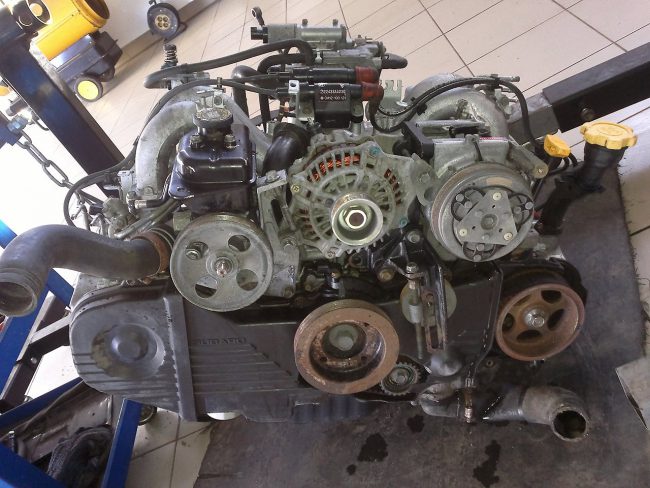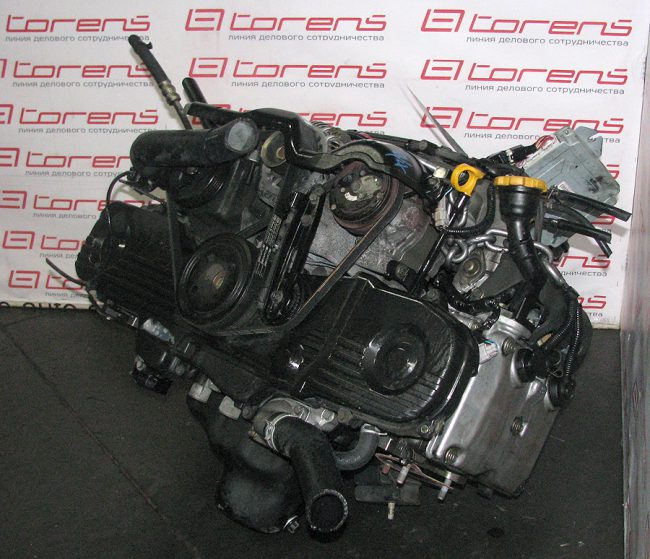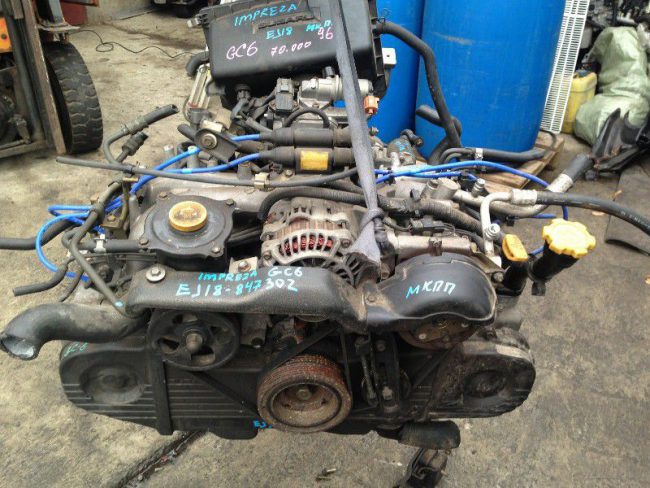
Subaru Impreza engines
Content
The model that most fans strongly associate with motor sports is the Subaru Impreza. Some consider it a model of cheap bad taste, others - the ultimate dream. However, the duality of points of view does not contradict the main conclusion that the legendary sedan has a special character.
The debut of the first generation Impreza (wagon and sedan) took place in 1992. Two years later, a coupe model was presented to the court of motorists, though in a rather limited edition. In the Subaru lineup, the Impreza quickly occupied the empty niche that formed between the Justy and Legacy versions. 
The design was based on the shortened platform of the predecessor - the previously mentioned "Legacy". Initially, the main goal of this project was to create a production car - a "base" participant, and, possibly, the champion of the WRC world rally. As a result, a bright and not quite ordinary car appeared, the distinctly expressed individuality of which provided him with wide recognition of buyers.
Subaru Impreza engines
The cars are equipped with boxer four-cylinder engines of the EJ modification in various versions. Simple "Impreza" versions received 1,6-liter "EJ16" and 1,5-liter "EJ15". Top-of-the-line variations, branded "Impreza WRX" and "Impreza WRX STI", were equipped with turbocharged "EJ20" and "EJ25", respectively. On weak models of the third generation, a one and a half liter EL15 power unit or a two-liter boxer diesel engine was installed.
The fourth version of the Subaru Impreza was "armed" with 2-liter "FB20" and 1,6-liter "FB16", and sports modifications of the car - "FA20" (for "WRX") and "EL25" / "EJ20" (" WRX STI") respectively. More clearly this information is presented in tables 1-5.
Table 1.
| Generation | Years of issue | Motor brand | Volume and power Engine | Type of transmission | Fuel used |
|---|---|---|---|---|---|
| I | 1992 – 2002 | EJ15 EJ15 | 1.5 (102,0 h.p.) | 5 manual transmission, 4 AKPP | A-92 (USA) |
| EJ15 | 1.5 (97,0 h.p.) | 5 MT, 4 AT | A-92 (USA) | ||
| EJ16 | 1.6 (100,0 h.p.) | 5 manual transmission, 4 AKPP | A-92 (USA) | ||
| EJ18 | 1.8 (115,0 h.p.) | 5 MT, 4 AT | A-92 (USA) | ||
| EJ18 | 1.8 (120,0 h.p.) | 5 manual transmission, 4 AKPP | A-92 (USA) | ||
| EJ22 | 2,2 (137,0 h.p.) | 5 MT, 4 AT | A-92 (USA) | ||
| EJ20E | 2,0 (125,0 h.p.) | 5 manual transmission, 4 AKPP | AI-95, AI - 98 | ||
| I | 1992 – 2002 | EJ20E | 2,0 (135,0 h.p.) | 5 MT, 4 AT | AI-95, AI - 98 |
| EJ20 | 2,0 (155,0 h.p.) | 5 manual transmission, 4 AKPP | AI-95, AI - 98 | ||
| EJ25 | 2,5 (167,0 h.p.) | 5 MT, 5 AT | AI-95, AI - 98 | ||
| EJ20G | 2,0 (220,0 h.p.) | 5 manual transmission, 4 AKPP | A-92 (USA) | ||
| EJ20G | 2,0 (240,0 h.p.) | 5 MT | AI-95, AI - 98 | ||
| EJ20G | 2,0 (250,0 h.p.) | 5 manual transmission, 4 AKPP | AI-95, AI - 98 | ||
| EJ20G | 2,0 (260,0 h.p.) | 5 MT, 4 AT | AI-95, AI - 98 | ||
| EJ20G | 2,0 (275,0 h.p.) | 5 manual transmission, 4 AKPP | AI-95, AI - 98 | ||
| EJ20G | 2,0 (280,0 h.p.) | 5 MT, 4 AT | A-92 (USA) |
Table 2.
| II | 2000 – 2007 | EL15 | 1.5 (100,0 h.p.) | 5 manual transmission, 4 AKPP | AI-92, AI - 95 |
|---|---|---|---|---|---|
| EL15 | 1.5 (110,0 h.p.) | 5 MT, 4 AT | A-92 (USA) | ||
| EJ16 | 1.6 (95,0 h.p.) | 5 manual transmission, 4 AKPP | AI-95 | ||
| EJ201 | 2,0 (125,0 h.p.) | 4 AT | AI-95, AI - 98 | ||
| EJ204 | 2,0 (160,0 h.p.) | 4 AKPP | AI-95, AI - 98 | ||
| EJ253, EJ251 | 2,5 (175,0 h.p.) | 5 MT | AI-95, AI - 98 | ||
| EJ205 | 2,0 (230,0 h.p.) | 5 manual transmission, 4 AKPP | AI-95 | ||
| EJ205 | 2,0 (250,0 h.p.) | 5 MT, 4 AT | AI-95 | ||
| EJ255 | 2,5 (230,0 h.p.) | 5 MKPP | AI-95 | ||
| EJ207 | 2,0 (265,0 h.p.) | 5 MT | AI-95 | ||
| EJ207 | 2,0 (280,0 h.p.) | 5 manual transmission, 4 AKPP | A-92 (USA) | ||
| EJ257 | 2,5 (280,0 h.p.) | 6 MT | AI-95 | ||
| EJ257 | 2,5 (300,0 h.p.) | 6 manual transmission, 5 AKPP | AI-95 |
Table 3.
| III | 2007 – 2014 | EJ15 | 1.5 (110,0 h.p.) | 5 MT, 4 AT | A-92 (USA) |
|---|---|---|---|---|---|
| EJ20E | 2,0 (140,0 h.p.) | 4 AKPP | A-92 (USA) | ||
| EJ25 | 2,5 (170,0 h.p.) | 5 MT, 4 AT | A-92 (USA) | ||
| EJ205 | 2,0 TD (250,0 HP) | 5 manual transmission, 4 AKPP | diesel | ||
| EJ255 Version 1 | 2,5 (230,0 h.p.) | 5 MT, 4 AT | A-92 (USA) | ||
| EJ255 Version 2 | 2,5 (265,0 h.p.) | 5 MKPP | A-92 (USA) | ||
| EJ207 | 2,0 (308,0 h.p.) | 5 MKPP | AI-95 | ||
| EJ207 | 2,0 (320,0 h.p.) | 5 MT | AI-95 | ||
| EJ257 | 2,5 (300,0 h.p.) | 6 manual transmission, 5 AKPP | AI-95 |
Table 4.
| IV | 2011 – 2016 | FB16 | 1,6i (115,0 hp) | 5MT, CVT | AI-95 |
|---|---|---|---|---|---|
| FB20 | 2,0 (150,0 h.p.) | 6 MKPP | diesel | ||
| FA20 | 2,0 (268,0 h.p.) | 6 MT | AI-95 | ||
| FA20 | 2,0 (.300,0 HP) | 6 manual transmission, 5 AKPP | AI-95 | ||
| EJ207 | 2,0 (308,0 h.p.) | 6 MT | AI-95 | ||
| EJ207 | 2,0 (328,0 h.p.) | 6 MKPP | AI-98 | ||
| EJ257 | 2,5 (305,0 h.p.) | 6 MT | A-92 (USA) |
Table 5.
| V | 2016 - p.t. | FB16 | 1,6i (115,0 hp) | 5 MKPP, CVT | AI-95 |
|---|---|---|---|---|---|
| FB20 | 2,0 (150,0 h.p.) | CVT | AI-95 |
Technical specifications
As can be seen from Table 1, the choice of powertrains for the Impreza is incredibly rich and varied. However, among true connoisseurs of this model, motors installed on the top versions of the WRX and WRX STI enjoy special preference. It is dictated by a high level of performance combined with their special technical and operational characteristics. To understand the pace of evolution of Impreza powertrains, consider several models: the two-liter EJ20E (135,0 hp) of the first generation, the 2,5-liter EJ25 (170,0) of the third generation and the 2,0-liter EJ207 (308,0 XNUMX hp) fourth generation. The data are presented in the table.

Table 6.
| Parameter name | Unit | EJ20E | EJ25 | EJ207 |
|---|---|---|---|---|
| Working volume | 3 cm | 1994 | 2457 | 1994 |
| Torque value | Nm/rpm | 181 / 4 000 | 230 / 6 000 | 422 / 4 400 |
| Power (max) | kW / hp | 99,0/135,0 | 125,0/170,0 | 227,0/308,0 |
| Oil consumption (per 1 km) | л | to 1,0 | to 1,0 | to 1,0 |
| Number of valves per cylinder | pcs | 4 | 4 | 4 |
| Bore | mm | 92 | 99.5 | 92 |
| Stroke | mm | 75 | 79 | 75 |
| Volume of the lubrication system | л | 4,0 (until 2007), 4,2 (after) | 4,0 (until 2007), 4,5 (after) | 4,0 (until 2007), 4,2 (after) |
| Brands of oils used | - | 0W30, 5W30, 5W40,10W30, 10W40 | 0W30, 5W30, 5W40,10W30, 10W40 | 0W30, 5W30, 5W40,10W30, 10W40 |
| Engine resource | thousand, km | 250+ | 250+ | 250+ |
| Own weight | kg | 147 | ~ 120,0 | 147 |
Design features and typical problems
The power units installed on the Impreza cars, like any complex mechanism, have weaknesses characteristic exclusively for it:
- In almost all modifications of the EJ20, sooner or later a knock appears in the fourth cylinder. The reason for its occurrence is the imperfection of the design of the cooling system. Of great importance is the duration of the knock. A short manifestation of this symptom within 3 minutes after starting is a regular situation, while a 10-minute tapping of a well-heated engine is a harbinger of an imminent overhaul.
- Deep seating of piston rings, initiating an increase in oil consumption (in versions equipped with a turbocharger).
- Increased wear and play of camshaft seals and valve covers causing lubricant leakage. Untimely elimination of such a problem will lead to a drop in oil pressure in the system and, as a result, oil starvation of the engine.
- EJ25 power units have thinner cylinder walls compared to other internal combustion engine models, which increases the risk of overheating, cylinder head deformation and gasket leakage.
- Modifications EJ257 and EJ255 often "suffer" from turning the liners.
- FB20s are notable for catalytic vulnerabilities due to high sensitivity to oil level and fuel quality. In addition, engines manufactured before 2013 often have serious defects in the cylinder block.
Resource and reliability
The main advantages of the Subaru Impreza power plants are excellent balance, high strength, minimal vibration that accompanies the work process, and a fairly long resource. Practice shows that most of the internal combustion engines installed on the Impreza do without a major overhaul of 250 - 300 thousand kilometers.
However, it should be noted that this statement does not apply to turbocharged sports car engines. All modifications of these units are operated in the mode of intensive loads, often leading to a bulkhead after 120 - 150 thousand mileage. There are also particularly difficult cases when the restoration of the motor is technically impossible.
The highest level of reliability is possessed by power plants, the working volume of which does not reach two liters: EJ18, EJ16 and EJ15. However, two-liter engines are more popular because they are more powerful.
According to the engineers - developers of the Subaru concern, the FB series models are endowed with a resource increased by a third.
In conclusion - the result of one of the surveys of specialists and fans of Subaru Impreza cars, designed to determine the best engines. The largest percentage of the highest ratings were earned by two-liter SOHS engines: EJ20E, EJ201, EJ202.

